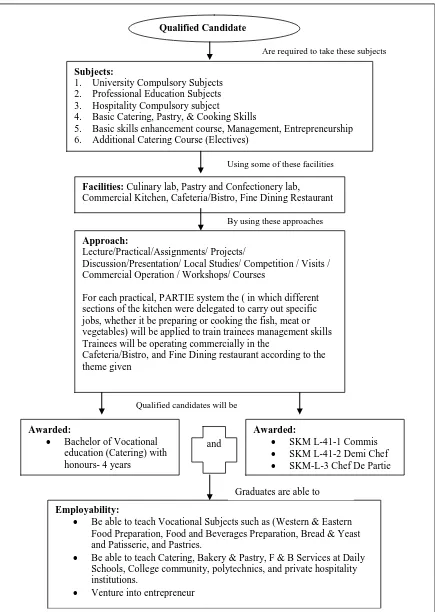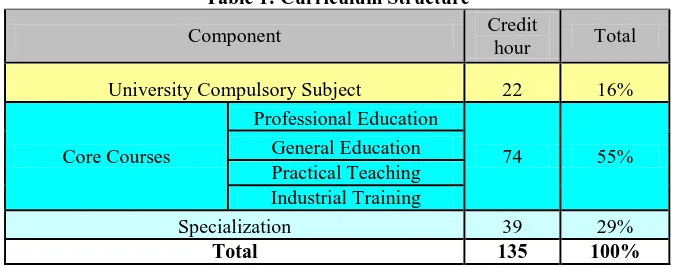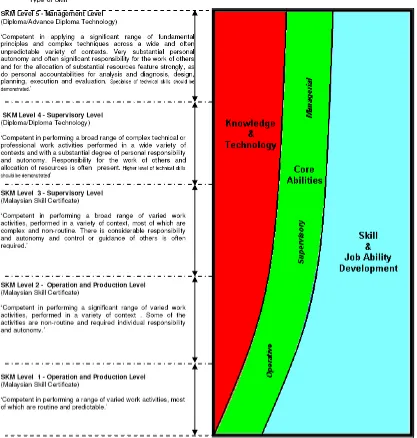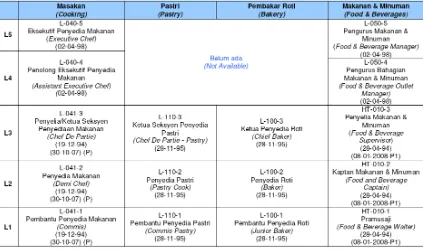INCORPORATING VOCATIONAL SKILLS TRAINING
IN TVET TEACHER EDUCATION
Wan Azlinda Wan Mohamed
Universiti Tun Hussein Onn Malaysia, Johor, Malaysia
Abstract
Highly skilled human capital is a prerequisite in effort by any nation to becoming a developed country. Recognising the importance of education as a vehicle to produce the skilled human capital, the Ministry of Education Malaysia has restructured the 69 Technical High Schools to Vocational High School, where students are expected to work on their skills and enhance their innovation and creativity. However, the key to excellence in education is quality teachers. Universiti Tun Hussein Onn Malaysia formerly known as Polytechnic Staff Training Centre was established on September 16, 1993, to train and produce polytechnics academic staff to become knowledgeable and skilful in various engineering fields. However, it has evolved to become a full-fledged Public University, training not only technical and vocational teachers, but also engineers, scientist and technologist. This paper will discuss how the Faculty of Technical Education at this University had developed a new curriculum that will incorporate Malaysian Skills Certificate (SKM) that is recognised by Ministry of Human Resource in the Bachelor of Vocational Education programme. Using National Occupational Skills Standards (NOSS) as a guide, the skills required to qualify SKM Level 1, 2, and 3 are embedded into courses of Bachelor of Vocational Education from Year 1 to Year 4. Thus, graduates of this programme are not only a qualified teacher who obtain their Bachelor Degree, but also a skilled worker who possess a Malaysian Skills Certificate. The philosophy is not only to educate teachers who are strong in their pedagogy and knowledge but also skilful in the area of vocation.
Keywords: curriculum, TVET teacher education, skills training
Introduction
Recognising the importance of education as a vehicle to produce the skilled human capital, the Ministry of Education Malaysia has restructured the 69 out of 90 Technical High Schools to Vocational High Schools, where students are expected to work on their skills and enhance their innovation and creativity. However, the key to excellence in education is quality teachers. With the increase number of Vocational High School, more teachers are required to teach Vocational subjects. A delegation from the Technical and Vocational Education Division, Ministry of Education (MOE), Malaysia had approached Universiti Tun Hussein Onn Malaysia (UTHM) to assist them in producing TVET teachers to fill the gap of qualified teachers in present schools. This is due to the increased enrolment of students in the vocational field to 13.08 % (from 15,060 to 17, 030 ) and 1634.0 % (from 1300 to 22550) in the skills area, and the falling number of students enrolment in Technical High Schools in 2009. MOE also require graduate vocational teachers who possess Malaysia Skill Certificate (awarded by the Ministry of Human Resource) to be posted at all secondary school. It was agreed that UTHM, or specifically the Faculty of Technical Education, UTHM, will help MOE to train these teachers.
Technology Management, Business & Entrepreneurship, and Faculty of Science, Arts, & Heritage.
This paper will discuss how the Faculty of Technical Education at this University had developed a new curriculum that will incorporate Malaysian Skills Certificate (SKM) that is recognised by Ministry of Human Resource in the Bachelor of Vocational Education programme. The Bachelors of Vocational Education (Catering) with honours programme will be used as an example how the curriculum was designed. The philosophy is not only to educate teachers who are strong in their pedagogy and knowledge but also skilful in the area of vocation.
Programme Design
By using these approaches
Qualified Candidate
Subjects:
1. University Compulsory Subjects 2. Professional Education Subjects 3. Hospitality Compulsory subject
4. Basic Catering, Pastry, & Cooking Skills
5. Basic skills enhancement course, Management, Entrepreneurship 6. Additional Catering Course (Electives)
Facilities: Culinary lab, Pastry and Confectionery lab, Commercial Kitchen, Cafeteria/Bistro, Fine Dining Restaurant
Approach:
Lecture/Practical/Assignments/ Projects/
Discussion/Presentation/ Local Studies/ Competition / Visits / Commercial Operation / Workshops/ Courses
For each practical, PARTIE system the ( in which different sections of the kitchen were delegated to carry out specific jobs, whether it be preparing or cooking the fish, meat or vegetables) will be applied to train trainees management skills Trainees will be operating commercially in the
Cafeteria/Bistro,and Fine Dining restaurant according to the theme given
Awarded:
• Bachelor of Vocational education (Catering) with honours- 4 years
Employability:
• Be able to teach Vocational Subjects such as (Western & Eastern Food Preparation, Food and Beverages Preparation, Bread & Yeast and Patisserie, and Pastries.
• Be able to teach Catering, Bakery & Pastry, F & B Services at Daily Schools, College community, polytechnics, and private hospitality institutions.
• Venture into entrepreneur
Awarded:
• SKM L-41-1 Commis
• SKM L-41-2 Demi Chef
• SKM-L-3 Chef De Partie
Are required to take these subjects
Using some of these facilities
Qualified candidates will be
and
[image:4.612.127.562.75.687.2]Graduates are able to
Curriculum Structure
Ministry of Higher Education
[image:5.612.87.427.405.539.2]The Ministry of Higher Education requires a minimum of 120 credits for all Bachelor Degree programme. Out of the 120 credits, 15-20 % are University Compulsory Subjects, 50 – 60 % are Core subjects and 25 – 30 % are Specialization course. For this example, our Bachelor of Vocational Education (Catering) with honours requires 135 credits (16 % University Compulsory Subjects, 55 % Vocational Subjects, 29 % Specialization subjects). The curriculum will include mastery body of knowledge, practical skills, social skills and responsibility, ethics and professionalism, critical thinking and problem solving, communications skills and teamwork, information management and lifelong learning and entrepreneurship and management. Table 1 shows the curriculum structure for the Bachelor of Vocational Education (Catering) with honours programme.
Table 1: Curriculum Structure
Component Credit
hour Total
University Compulsory Subject 22 16%
Core Courses
Professional Education
74 55%
General Education Practical Teaching Industrial Training
Specialization 39 29%
Total 135 100%
between races. The Final Year Project consisting of two semesters will make the students aware and prepare for the workplace competency and needs. The industrial training will equip students the real job and present technology. Students will be introduced to good work practices, work ethics and work competency during industrial training.
Malaysian Skills Certificate requirement
To qualify for the Malaysian Skills Certificate, students are expected to acquire certain competency before they are awarded the certificate. The concept of competency focuses on what is expected of an employee in the workplace rather than on the learning process; and embodies the ability to transfer and apply skills and knowledge to new situations and environments. Competency is a broad concept that includes all aspects of work performance and not only narrow task skills. Competency includes the requirement to: -
• perform individual tasks (task skills)
• manage a number of different tasks within the job (task management skills) • respond to irregularities and breakdowns in routine
(contingency management skills)
• deal with the responsibilities and expectations of the work environment, including working with others (job/role environment skills).
Figure 2: Level of SKM level and its competency (Source: Department of Skills Development, Ministry of Human Resource, Malaysia)
The Faculty has also identified the appropriate skills that they will be trained in this program. In this case, graduates from Bachelor of Vocational Education (Catering) with Honours will also undertake skill training, where qualified students, after being assessed, verified and had fulfilled the Malaysian Skill Certification requirements, shall be awarded with Sijil Kemahiran Malaysia (SKM) for to Level 3 (SKM L-41-1 Commis, SKM L-41-2 Demi Chef, and SKM-L-41-3 Chef De Partie) by the Department of Skills Training, Ministry of Human Resources. Table 2 shows the NOSS available under Subsector Hotel.
Table 2: NOSS for Sub Sector Hotel (Sector Hospitality & Tourism) (Source: Registry of National Occupational Skills Standard (NOSS))
Integrating Vocational Skills into the Bachelor Programme
either the Core Courses or Vocational Education courses or the Specialised courses. For example, Commis is designated to work as an assistant cook within the kitchen of a hotel, restaurant or other commercial food production unit (Department of Skills Standard, 2010). In particular he/ she:
1. Handle Food Items
2. Perform Cooking Methods 3. Produce Breakfast
4. Produce Stocks and Soups 5. Produce Appetizers 6. Produce Sauces and Gravy 7. Produce Rice Dishes
8. Produce Farinaceous Products 9. Produce Main Courses
10. Produce Desserts
11. Handle Off Premise Catering
Skills for perform cooking methods; will be taught in BBK 1743 Basic Culinary, which in the Specialization course, where one of the topics is Cooking Principles. The subtopic includes (i) Dry heat cooking methods; (ii) Moist heat cooking methods; (ii) Dry and Moist heat cooking method; (iv) Cooking method for different foods and recipes.
Program Potential
teach in Community Colleges, Polytechnics, Private Hospitality Institution, as they will be able to teach in the field of Catering, Bakery & Pastry or Food & Beverage Service.
Conclusion
This is a top down programme designed for the Ministry of Education, Malaysia. Qualified graduates will be awarded Bachelor of vocational Education with honours and Malaysian Skills Certificate up to level 3. The philosophy is not only to educate teachers who are strong in their pedagogy and knowledge but also skilful in the area of vocation.
Acknowledgement
Reference
Boston Consulting Group (4th Mei 2009). Strategy Package for Higher Growth & Structural Change. Human Capital for a High Income Economy. Draft Final Report.
Department of Skills Development, Ministry of Human Resource, Malaysia website: http://www.dsd.gov.my
Registry of National Occupational Skills Standard (NOSS) (1 June 2009). Department of Skills Development, Ministry of Human Resource, Malaysia.
Standard Practice. National Occupational Skill Standard (Noss) For Commis, Demi Chef And Chef De Partie, (2010). Department of Skills Standard Ministry of Human Resource,
Malaysia. Retrieved on June 10th 2010 at
Appendix 1:(Source: Department of Skills Department, Ministry of Human Resource)
Job Profile for
1. Commis Level1
2. DemiChef Level 2



